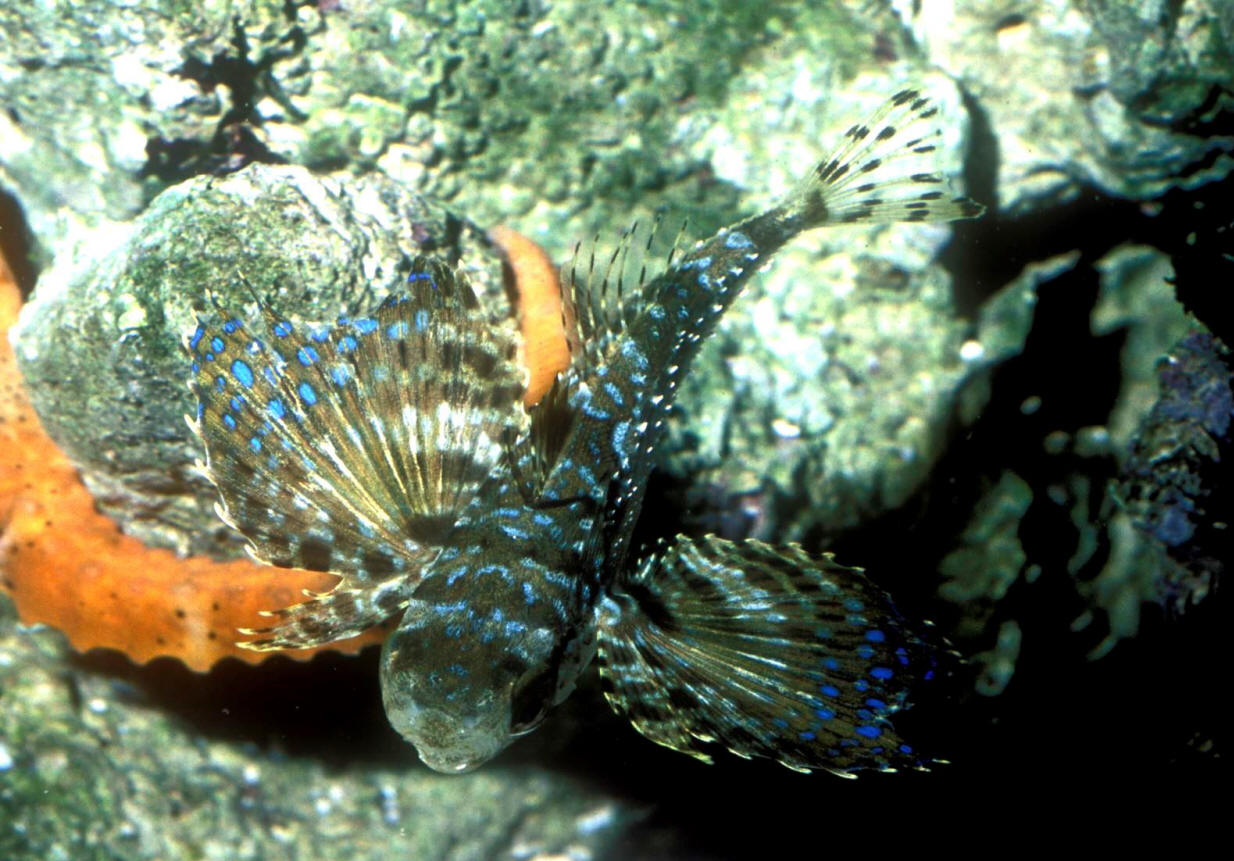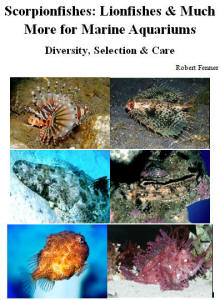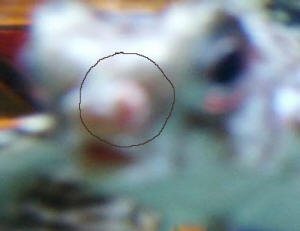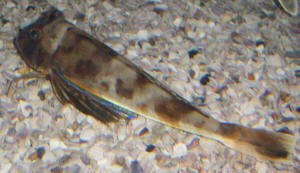|
FAQs about Flying
Gurnards
Related Articles: Flying Gurnards,
Related FAQs:
A delightful 3 in. Dactylopterus volitans in a stunning
display at the 04 Interzoo show.
|

|
Scorpionfishes:
Lionfishes & Much More for Marine Aquariums
Diversity, Selection & Care
New eBook on Amazon: Available
here
New Print Book on Create Space: Available
here
by Robert (Bob) Fenner |
 |
Fascinated by Sea Robins 4/9/13
Hi there!
<Kim>
I recently found out about the cool family of Gurnard and Sea Robins by
a picture my husband stumbled across on Facebook... I believe the
picture was of Dactyloptena Orientalis, but it sounds like they wouldn't
be very easy to put in a community due to their size and tank layout
requirements. The Banded Sea Robin (Prionotus sp.) seems much more
promising though! I'm a long ways off from having a saltwater tank that
I could keep one in (still love to plan though), but all my attempts to
research more about what sort of aquarium size/layout they need, what
sort of tankmates they can be kept with, etc have come up frustratingly
short. It seems like there's at least a little bit of info about the
Dactyloptena family,
<Dactylopterid... family Dactylopteridae>
but there's virtually nothing out there on their aquarium care other
than LiveAquaria's out of stock page for them, and I prefer not to use a
seller's page as my primary research source.
<Wise; though Dr. F and S's sites are generally excellent
information-wise>
Any information you can provide about them would be appreciated, and/or
if you can point me to any books or websites about them that would be
great too! Thank you!
~Kim
<This family's members can be kept in captivity... better to start w/
"medium" sized specimens... 4-5 inches overall length... As large and
uncluttered system as possible/practical... at least four feet in
length, eighteen inches in width... Fine/r substrate... Do search for
the species you can find's natural habitat notes... Some are cool/er
water... Not appropriate for tropical settings. Bob Fenner>
| Gurnard disease? Dactylopterus
volitans 3/31/07 Hello Crew, <Elizabeth> I do
have a million questions for you but all in good time and after
reading your FAQ's in depth . Today's question is slightly
more urgent than those, and maybe not for lack of reading the
wonderful information available on your site, but my difficulty in
understanding and applying it. I'm looking to be a bit more
proactive and fix this problem before it becomes any worse. I have
a fish, a Dactylopterus volitans (about 5-6" presently) to be
specific with a slight (getting to be more severe) facial growth of
sorts. <Neat animals... see in the wild, and occasionally
offered in the trade... Do need lots of room, water movement,
filtration> (pictures attached) First, tank stats. 60 gal
<Way too small> (a 90 gal will be his new tank for the near
future, and a 220 in time) with about 60 lbs of live
rock. Presently running a Fluval 404 and a skimmer (Coralife, yuck,
I know) rated for a 125 gal tank. <Inadequate> Ammonia reads
zero, nitrite zero as well, and nitrate between 10 and 20ppm.
<Borderline high> His cohabitants are a horseshoe crab <A
coldwater species?> and a Dendrochirus biocellatus. They all get
a nicely varied diet full of vitamins and garlic when needed.
Squid, shrimp, mussels, fish (not gold), krill, brine shrimp,
plankton, blood/black worms and a few ghost shrimp as
snacks. (I just got the Fu Manchu to start eating
non-live after half a year of trying and am Very proud of him)
<Neat> The situation is as follows: Four days ago the gurnard
developed a small pin-head sized red protruding spot below his left
"nostril" and above his "lip" I summed this up
to him having run into something and scratched himself up a bit, as
he's been getting older he's been more skittish/prone to
what I like to call "freak outs" where he'll
haphazardly dart across the tank or try and jump upon being
startled. <Yes... and VERY dangerous... too likely swam into the
Lion...> After that appeared (maybe not the best idea) but I
figured since he was growing he might need more swimming space to
feel comfortable and moved the rockwork to compensate. <Needs
that larger tank... now> It remained the same size and colour
for the next day and a half/two days. Since I last observed him in
detail (yesterday) it's increased in size to about
1/4" diameter and is protruding by a couple of mm. It's
mottled red and white, and doesn't SEEM to be causing him any
discomfort. He's still eating voraciously, swimming as normal
(though he has been swimming "into" (not in a disoriented
way, but in a bored "i don't have enough space" way)
<Are you listening to what this fish is trying to "tell
you"?> the glass more than before, but it could just be
because of the adjusted rockwork, but maybe scratching the thing on
his face. Also, the Fu doesn't seem to have changed behaviour
and looks fine. Nothing out of the ordinary has come into the tank
in months. From my reading I thought it could be a fungus or
lymphocystis, <Mmm, no... "it's" the environment,
tankmates> however I am afraid of medicating improperly, or at
all if I don't need to. <... you don't> I don't
know what else could be a variable, so I'll leave it in your
capable hands to try and help find out what it is and what I need
to do before it becomes a big problem. Lastly, I apologize for the
blurry pictures and/or picture overload, they were the best my
moving fish would allow me. I hope they help. We thank you Very
Much for your time and advice. All the best, -Liz <Please step
up your plans... to near practical maximum, to move this animal to
more suitable quarters. Bob Fenner> |
  |
| Two IDs please: bizarre walking fish &
double-ended "thing" 2/20/07 Hi guys,
First up: For a nice day out yesterday, my partner and I decided to
go to the Sydney Aquarium, since we've recently (6 months)
developed the hobby and started our own tank. While there,
thankfully with camera in tow, I spotted a truly bizarre fish
in a tank (not sure what type of water, but most probably cold
salt water) which unfortunately did not have any occupant
labels, nor any nearby staff. <A note here for folks working in
such facilities...> The fish looks rather normal from afar, and
likes to sit on the bottom, only moving when a ray came and
disturbed it. Up close however, you can see that just behind
it's head and in front of it's side fins, there are 3
pairs of very crustacean-esque articulated legs (which it has
complete control over). <Well-stated> As well as this,
when disturbed it spreads it's side fins to glide over the
substrate, and although the rest of the fish is a mottled
brown colour, the top of the fins is a fabulous spotted
iridescent blue, almost like a butterfly. <Ah yes>
I've attached two photos, one showing the legs as best
I can, and the other a top down of the fins (sorry about the
poor quality). Size is approx 20cm head to tip of tail (about
8 inches). It's "wing" span is about half
that. I've searched under all the phrases I can think of both
in WWM and Google, with no luck. Any idea what this is?
(We've taken to calling it a blue-finned butterfly-lobster
fish, but I'd be pretty sure that's not it's
name!) <Heee! Is almost undoubtedly a "Gurnard", a
Dactylopterid... see the Net with this name... or Fishbase.org
particularly... with a search by country, then family... Bob
Fenner> |
|

|
Smart Reader Gives Genus and Species for "Flying
Gurnard" >Dear Crew: >>Hello. I am
interested in purchasing two sea robins (Dactylopterus volitans) at a
new marine shop I visited today, and would like to know if they are
appropriate for the tank I have. I have a FOWLR 6 x 2 x 2. I cannot
find any information locally regarding this species. >>They
have a couple of common names, one, of course, is the sea robin, the
other is flying gurnard. I am unsure as to whether or not this animal
is one of the species of flying fish, though the Fishbase description
speaks of a benthic associated animal that feeds on benthic inverts and
the like. >Do you have any idea of the size they will achieve
when adult and the type of care needed? >>As per
fishbase.org they will hit about 90cm (36") by adulthood. That is
one BIG fish for an aquarium, and your tank would not allow space to
turn about, let alone comfort. If it were double the current dimensions
horizontally, you might be more on track for these animals.
>Their present size is approx 2 inches. In the tank I have a yellow
tang, African fireball angel, lime green wrasse, 3 ", 2 Perc's
and BTA. Thank you. Sincerely, Simon >>Given what
I've found of them, I would say they ought only be housed in
systems of at least 2-3 hundred, or even a few thousand gallons.
Marina
Simon's Lighter a Few Quid - Dactylopteridae Follow-up
II >Thanks again Marina for your prompt reply.
>>My pleasure, Simon. >Just a quickie before hit the
sack. >>You really shouldn't mention such things to a
woman of my nature. My significant other lives over 600 miles away
and.. well.. let's just leave it at that. >The Turboflotor
skimmer. >>Right! I've forwarded this message to Scott
Fellman. >whenever I try to put ozone through this, it just
stops all bubbles dead. I have written to Aqua-Medic but have not yet
had a response....... Will let you know. >>And in the
meantime, maybe Scott's got some advice for you (and me).
>Must get some kip...Well soon anyway.... Tis nearly 1am and been a
long day... Was just increasing the flow in the tank by adding an extra
Eheim 1060 pump to the sump with an extra overflow and what happens in
the middle of all this??? >>I haven't a clue.
>Yes you got it,.... a bloody power cut. >>WHAT?? Talk
about some pisspoor timing! >Now have around 40 gallons of
water to clean up, tomorrow was the day to actually fit the larger sump
!!!! Just goes to show...... Sods law again !! >>In Puerto
Rico we'd say something along the lines of "Ay, carajo! CONO!
(with the tilde over the 'n')" >G'night
Marina >>Criminy, mine's better than yours I'm
afraid. >Sleep well.... I know I will! >>Will do,
seems I'm spending the Easter weekend all by my lonesome. Means I
get to walk about the house in my birthday suit. An almost perfect
weekend. Marina
Armored Searobins/Gurnards I was wondering if you could tell
me how many species of spiny sea robins live in the Atlantic and are
there any differences other than size between sub-adults and
an adults .We are working on what I believe to be a 20
million year old skeleton of a spiny sea robin and would like to hear
what you know about the modern spiny sea robins. Thank you <Well,
according to Nelson, J.S., 1994. Fishes of the world. 3rd ed.. John
Wiley & Sons, Inc. New York. 600 p. the subfamily Peristedinae (of
the family Triglidae) has four genera of about 30 species. You might
look up these on fishbase.org with the genera Gargariscus, Heminodus,
Peistedion, Satyrichthys to find their distribution. Bob
Fenner> Bill Counterman Calvert Marine
Museum Department of Paleontology 410-326-2042 ext.61
Flying Gurnard Can I fit a flying gurnard in a 45gal fish
tank? How big does it grow <one of the few true "flying
fishes" this species needs great long tanks to thrive if even
survive in captivity. I must say that your tank cannot host this
animal. Please do admire it from afar. Anthony>
Flying Gurnard II can u send me some pages on flying gurnards
<alas, we do not have any Articles on flying gurnards... they are
mostly kept by public aquariums. Do pursue other keyword/net searches
of this fish by scientific name: Dactylopterus volitans. Best regards,
Anthony>
new tank/Gurnards First off, I would like to say thank you
for your indirect help with my salt water endeavours (I read your site
almost everyday). Your website has been a great help, and the source of
a tremendous amount of information. Now for the questions. I recently
purchased a 180G glass tank out of the newspaper (got it for $250
including stand, canopy, protein skimmer....and it is in good
condition, just needed a cleaning). <What a bargain> The
one problem I have is it has a built in overflow at one of the ends. I
want to lower the water level a little but this overflow is fixed. Have
any ideas on how I can accomplish this? <A few... if the
supports/walls of the overflow towers are glass, DO NOT try cutting
them... unless you want to cut them out and replace them entirely... Do
consider rigging "overflow constant level boxes" like those
made by CPR for removing water from systems to sumps... And do try just
running the system as it is arranged if you have any doubt as to
whether this is something you want to modify or no...> Also in my
current 30G reef, I have a few silver looking bubbles on the live rock.
I have seen one popped, and it almost looked like all that was left was
a plastic skin. Any ideas what this could be? <Yes... Green
Algae of the Order Valoniaceae... see the "Green Algae"
section on the Marine Index of our website for pix and more:
www.WetWebMedia.com as usual...> And finally, I have been trying to
find information on Dactylopterus Volitans (Flying Gurnard) but
can't seem to find anything. Do you know if they are reef safe,
what they eat, an! <Are reef safe, but messy... eat live foods, some
can be trained... much like Lionfishes...> d tips for keeping them?
Thank you for the help. kevin <Not many "tips"... are
relatively hardy... just must be fed... Kept by public aquariums in
many places in the world. Bob Fenner>
Scorpionfishes:
Lionfishes & Much More for Marine Aquariums
Diversity, Selection & Care
New eBook on Amazon: Available
here
New Print Book on Create Space: Available
here
by Robert (Bob) Fenner |
 |
|
|

